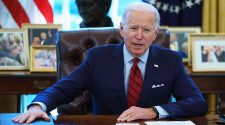Here’s what you need to know:

Joseph R. Biden Jr., under increasing pressure to confront President Trump’s false accusations that he is radically anti-law enforcement, is traveling to Pittsburgh on Monday to make the case that it is Mr. Trump who is endangering the nation.
The address represents Mr. Biden’s most prominent and forceful effort yet to deflect the barrage of criticism Republicans levied against him at their convention last week, and attempt to turn the spotlight back on what he will cast as Mr. Trump’s leadership failures.
Against a backdrop of street violence unfolding in multiple cities across the nation, Mr. Biden is expected to condemn destruction, to note that chaos is unfolding on the president’s watch, and to charge that it is Mr. Trump who is making the country unsafe, whether by stoking division amid an outcry over racism and police brutality, or through his handling of the coronavirus crisis and the economy.
How Mr. Biden handles the unrest playing out in places including the battleground state of Wisconsin may shape the contours of the fall campaign, at a moment when a number of Democrats have urged his team to be more visible on the issue.
“Does anyone believe there will be less violence in America if Donald Trump is re-elected?” Mr. Biden is expected to say, according to an excerpt from prepared remarks. “We need justice in America. And we need safety in America. We are facing multiple crises — crises that, under Donald Trump, keep multiplying.”
Much of the Republican argument against Mr. Biden on “law and order” issues is rooted in false claims about Mr. Biden’s positions. He opposes defunding the police, for example, though Republicans have inaccurately said he supports that policy.
And contrary to Republican distortions of his record on battling crime, Mr. Biden, to the discomfort of progressives and some criminal justice advocates, played a key role in shepherding the 1994 crime bill into law. The bill was supported at the time by a wide array of figures including President Bill Clinton and Rudolph W. Giuliani, who was then New York’s mayor, but many experts now associate with mass incarceration.
But some Democrats worry that Mr. Biden has not been visible enough in laying out his own views on such searing issues in recent weeks, and concerned allies have been on the phone with Mr. Biden’s team in recent days, urging him to get out more.
“I’m worried because I think Donald Trump cannot win the election based on what he has done as president,” said former Gov. Ed Rendell of Pennsylvania, in a Sunday afternoon interview. “So therefore he has to find some way to make his opposition the issue.”
Mr. Rendell, who is not alone in a concern more Democrats share privately, said he had made clear to members of Mr. Biden’s campaign that the Democratic nominee should communicate his position on law enforcement in a high-profile way rather than, for example, “an interview here at two o’clock in the afternoon where it may or may not be shown on the evening news.”
Mr. Biden intends to give a major speech Monday afternoon in Pittsburgh, a departure for a candidate who has rarely traveled far from his home in Delaware since the coronavirus shuttered the campaign trail in March, as his team cautiously weighs travel to other battleground states, including discussions of a trip to Kenosha.
Mr. Trump is expected to visit Kenosha on Tuesday, though a growing chorus of Wisconsin officials have urged him not to come. Earlier this month in Kenosha, a white police officer shot a Black man, Jacob Blake, seven times, sparking outrage, protests and clashes that in some cases turned violent. A white teenager who confronted demonstrators with a gun — and who was pictured at a Trump rally earlier this year — was arrested in connection with two shooting deaths, and faces charges of homicide.
In Portland over the weekend, a man affiliated with a right-wing group was shot and killed amid a pro-Trump caravan into downtown, prompting an onslaught of tweets from the president seeking to pin the blame on the Democrats, part of a barrage of online communication that promoted fringe conspiracy theories.
“He may believe mouthing the words ‘law and order’ makes him strong, but his failure to call on his own supporters to stop acting as an armed militia in this country shows you how weak he is,” Mr. Biden is expected to say.

Representative Carolyn B. Maloney, Democrat of New York and the chairwoman of the House Oversight Committee, said Monday that she would subpoena Louis DeJoy, the postmaster general, for documents she said he had withheld from Congress related to mail delays and communications with the Trump campaign.
Ms. Maloney sent a memorandum notifying members of the panel of her plan to issue the subpoena, meaning it will likely be delivered to Mr. DeJoy by Wednesday.
Over the last two months, many members of Congress have sought documents from Mr. DeJoy — a megadonor and Trump ally recently hired to run the Postal Service — concerning delays in election mail since he has taken the helm, the removal of postal service machinery and the process by which he was chosen to run the agency.
Democrats have raised concerns in recent weeks that Mr. DeJoy is interfering with the mail as part of a broader effort by Mr. Trump to sow distrust in voting by mail ahead of a pandemic-era election in which mail-in ballots will play an outsized role.
Mr. DeJoy has yet to provide any documents to Congress since a hearing last week of Ms. Maloney’s committee, during which members grilled the postmaster general on widespread reports of dysfunction and slow mail under his leadership.
Ms. Maloney said she received a letter from Mr. DeJoy Friday night that said: “I trust my August 24 testimony before the Committee on Oversight and Reform clarified any outstanding questions you had.”
The subpoena “makes clear as a legal matter that the production of these documents is mandatory,” Ms. Maloney said in a statement.

Will you have enough time to vote by mail in your state?
The simple answer is: Yes, but don’t procrastinate.
In the 2018 midterm elections, more than a quarter of all rejected mail ballots — 114,000 votes — were not counted because they were late. But voters should have plenty of time to cast a ballot by mail in November, as long as they don’t wait until the last minute to request one.
Most states begin sending ballots to voters more than a month before Election Day. North Carolina, for example, will begin mailing ballots on Sept. 4 — a full 60 days before the general election. Alabama will begin on Sept. 9, and Kentucky on Sept. 15.
However, in 35 states, voters can request ballots so close to Election Day that it may not be feasible for their ballots to be mailed to them and sent back to election officials in time to be counted.

A group of Republicans dedicated to defeating President Trump is going on the attack on Florida, preparing a multimillion-dollar advertising campaign aimed at undercutting Mr. Trump with moderate and independent voters in the country’s largest swing state.
The organization, Republican Voters Against Trump, has assembled parts of former Gov. Jeb Bush’s political operation to launch the offensive, which it has dubbed “Project Orange Crush.” Mike Murphy, an architect of Mr. Bush’s campaigns in the state and strategist for Mr. Bush’s 2016 super PAC, is directing the campaign, aided by David B. Hill, a former Bush pollster, and Tim Miller, a former Bush spokesman.
Mr. Murphy said in an interview that the group had already raised several million dollars for the campaign and had conducted polling and focus groups in the state. He said it planned to focus on several hundred thousand voters who could be the political tipping point in a state where elections are routinely decided by a percentage point or less.
Mr. Murphy said the group’s research had found a large number of moderate suburbanites and retirees, including along Florida’s western coastline and the Jacksonville area in the state’s northeastern corner, who were open to voting for Mr. Biden but needed some additional persuasion to break their typical preference for the G.O.P.
“There are cracks in the wall, but they need a few good sledgehammer blows,” Mr. Murphy said.
The Florida campaign is the latest of several aggressive steps recently by Republican Voters Against Trump, a group founded by the former Weekly Standard editor Bill Kristol and Sarah Longwell, a Republican political strategist.
Earlier this month, the organization unveiled a video featuring Miles Taylor, a former senior official at the Department of Homeland Security under Mr. Trump, detailing what he called “dangerous” and “terrifying” behavior by the president.
The group’s strategists explained their choice to focus on Florida in a memo: If Mr. Biden were to capture the state’s 29 electoral votes, he would likely need to win only one other major battleground state, such as Michigan or Wisconsin, to deny Mr. Trump a second term. Their campaign is aimed at about 450,000 Floridians in the political middle who they believe are capable of deciding the race.
While some Democrats have grown frustrated with Florida because of the high cost of campaigning there and its persistent tilt to the right in state-level elections, the memo argued that Florida could help counter Mr. Trump’s efforts to polarize the Midwestern states along purely racial lines.
“It is no secret that Trump will use reckless and racially inflammatory language and grievance politics to try to rally his voters,” the memo said, adding, “Unlike those states, with large majority white populations, Florida’s electorate is far more diverse.”
The group said it would use a mix of television and online advertising, and Mr. Murphy said radio and direct-mail advertising would also be in the mix. The ads are slated to start after Labor Day.
“What we are going to do is go right at the suburbanites,” Mr. Murphy said, “and surround them.”

President Trump saw no improvement in his favorability rating after the Republican National Convention, according to an ABC News/Ipsos poll released on Sunday.
The survey found that just 31 percent of Americans hold a positive view of the president, basically unchanged from a poll taken before the party conventions. (Most other polls before the conventions had placed his approval rating considerably higher, often in the low 40s. More post-convention polling is sure to arrive in the days ahead.)
Despite the various speakers at the convention who extolled Mr. Trump’s response to the coronavirus crisis, the ABC/Ipsos poll, which had a margin of sampling error of plus or minus 4 percentage points, also showed no bump in support for his handling of the outbreak. Thirty-five percent of respondents gave him positive marks on confronting the pandemic, on par with his numbers from July.
And while much of the convention was dedicated to tarring Joseph R. Biden Jr., the poll also showed no significant change in Mr. Biden’s favorability rating, which stood at 46 percent. He had received a boost after the Democratic convention; in early August, his favorability had been 40 percent.
For both the Democratic and G.O.P. conventions, about half of Americans reported watching at least a glimpse of them. While 53 percent of Americans said they generally approved of what the Democrats had said and done at their convention, just 37 percent said the same of the Republicans’ messages, according to the poll.

Representative Joseph P. Kennedy III is trailing Senator Edward J. Markey in every poll ahead of the Democratic Senate primary in Massachusetts on Tuesday, and may become the first Kennedy to lose a race in the state.
He is struggling with idealistic young liberals and older, affluent white Democrats, the sort of voters who in an earlier era idolized his grandfather, Robert F. Kennedy, and his great-uncles.
Mr. Kennedy pointed to his strength with working-class Democrats and voters of color who are bearing the brunt of the coronavirus pandemic, all but scorning what he suggested was the hypocrisy of white liberals.
“For a progressive left that says that they care about these racial inequities, these structural inequities, economic inequities, health care inequities, the folks that are on the other side of that are overwhelmingly supporting me in this race,” he said. “Yet there seems to be a cognitive dissonance.”
It wasn’t supposed to be this way — at least not in the minds of Massachusetts Democrats, who have spent a lifetime watching a parade of Kennedys win elections against little opposition. When Mr. Kennedy first considered challenging Mr. Markey last year, some in the party wondered if the 74-year-old incumbent would step aside for the 39-year-old political scion.
Instead, Mr. Markey, who was elected to the House before Mr. Kennedy was born, has harnessed the energy of the ascendant left and wielded his rival’s gilded legacy against him. And he has used his support from Representative Alexandria Ocasio-Cortez and their joint authorship of the Green New Deal to establish himself as the clear front-runner.
Mr. Markey’s strength illustrates the growing clout of progressives in the Democratic Party, particularly in states and districts that are heavily metropolitan and filled with well-educated voters. Each of the Democrats who have unseated incumbents in primaries in 2018 or this year did so in House seats anchored in cities or close-in suburbs, which is where most of the votes in Massachusetts can be found.
What’s so striking about the Senate race here, though, is that it’s the incumbent who framed himself as the bold insurgent.

Representative Steve Scalise, the second-ranking House Republican, replaced a video that Twitter flagged as having been manipulated because the words of a progressive activist who was questioning Joseph R. Biden Jr. on his stance on defunding the police were misleadingly grafted together.
The activist, Ady Barkan, called out Mr. Scalise, the minority whip of the House of Representatives, on Twitter Sunday afternoon, saying he had “doctored my words for your own political gain” and demanding that he remove the video he had posted in a tweet.
“I have lost my ability to speak, but not my agency or my thoughts,” tweeted Mr. Barkan, who has been diagnosed with amyotrophic lateral sclerosis, or A.L.S. and speaks with the help of a computerized voice.
“You owe the entire disability community an apology.”
These are not my words.
I have lost my ability to speak, but not my agency or my thoughts.
You and your team have doctored my words for your own political gain.
Please remove this video immediately. You owe the entire disability community an apology. https://t.co/N6G5RgMXlO
— Ady Barkan (@AdyBarkan) August 30, 2020
President Trump’s attack on Mr. Biden’s candidacy has charged that the Democratic nominee wants to “defund the police,” a phrase that has a range of meanings — from shifting some money from policing budgets to social services to outright cutting off funding for the police. Mr. Biden has repeatedly said that he does not support calls to defund the police entirely and that while federal grants should be used to incentivize reform, decisions about local department funding should be made at a local level.
To bolster the argument being advanced by the Trump campaign, Mr. Scalise tweeted a video showing scenes of chaos and destruction. It included a clip of a question by Mr. Barkan and a response from Mr. Biden that had been edited in a way that removed context and added words that made it appear as through the former vice president was asked about police funding more directly.
The doctored video showed Mr. Barkan asking Mr. Biden: “Do we agree that we can redirect some of the funding for police?”
Mr. Biden responds: “Yes. Absolutely.”
But originally published version of the video of the interview shows that Mr. Barkan did not say the words “for police” at the end of his question.
Earlier in the interview Mr. Barkan had argued, “We can reduce the responsibilities assigned to the police and redirect some of the funding for police into social services, mental health counseling, and affordable housing.” Mr. Biden responded by listing several police reforms he had called for. And Mr. Barkan eventually interjected: “But do we agree that we can redirect some of the funding?”
“Yes,” Mr. Biden said. “Absolutely.”
The tweet containing the video was eventually “labeled based on our Synthetic and Manipulated Media policy,” a Twitter spokeswoman confirmed Monday, and was eventually removed.
“While Joe Biden clearly said “yes,” twice, to the question of his support to redirect money away from police, we will honor the request of @AdyBarkan and remove the portion of his interview from our video,” Mr. Scalise wrote in a tweet Sunday night.
In an email Monday morning, a spokeswoman for Mr. Scalise, Lauren Fine, said his team had “condensed” Mr. Barkan’s full remarks “to the essence of what he was asking, as is common practice for clips run on TV and social media, no matter the speaker.”
In a statement, Andrew Bates, a Biden campaign spokesman, called the edited video a “deep fake” that was “particularly outrageous, and is a warning sign for other kinds of categorically dishonest manipulation.”

The decision by the nation’s top intelligence official to halt classified, in-person briefings to Congress about foreign interference in a presidential election that is just nine weeks away exposes the fundamental tension about who needs to know this information: just the president, or the voters whose election infrastructure, and minds, are the target of the hacking?
The intelligence agencies are built to funnel a stream of secret findings to the president, his staff and the military to inform their actions.
President Trump has made it abundantly clear that he does not believe the overwhelming evidence, detailed in thousands of pages of investigative reports by the Republican-led Senate Intelligence Committee and indictments of Russian intelligence officers by his own Justice Department, that Moscow interfered in the 2016 election, and is at it again.
One of the bitter lessons of the last election is that hose defending against disinformation campaigns include not just the president and his staff but also state and city election officials; Facebook, Twitter and Google; and voters themselves, who need to know who is generating or amplifying the messages they see running across their screens.
And if they do not understand the threat assessments, they will enter the most critical phase of the election — those vulnerable weeks when everything counts and adversaries have a brief window to take their best shot — without understanding the battle space.
So it is no surprise that as soon as word leaked about the decision by the director of national intelligence, John Ratcliffe, to give Congress only written updates about the latest intelligence, former Vice President Joseph R. Biden Jr. led the parade of accusations that Mr. Trump was paving the way for a second round of election interference.
“Nothing is more important than the security and integrity of our elections,” Mr. Biden, said in a statement on Saturday. “And we know that President Trump is unwilling to take action to protect them. That leaves Congress as the best defender of our democracy.
“There can be only one conclusion: President Trump is hoping Vladimir Putin will once more boost his candidacy and cover his horrific failures to lead our country through the multiple crises we are facing,” Mr. Biden added. “And he does not want the American people to know the steps Vladimir Putin is taking to help Trump get re-elected or why Putin is eager to intervene, because Donald Trump’s foreign policy has been a gift to the Kremlin.”

President Trump unleashed an especially intense barrage of Twitter messages over the weekend, embracing fringe conspiracy theories claiming that the coronavirus death toll has been exaggerated and that street protests are actually an organized coup d’état against him.
In a concentrated predawn burst, the president posted or reposted 89 messages between 5:49 a.m. and 8:04 a.m. on Sunday on top of 18 the night before, many of them inflammatory comments or assertions about violent clashes in Portland, Ore., where a man wearing the hat of a far-right, pro-Trump group was shot and killed Saturday after a large group of Mr. Trump’s supporters traveled through the streets. He resumed on Sunday night.
In the blast of social media messages, Mr. Trump also embraced a call to imprison Gov. Andrew M. Cuomo of New York, threatened to send federal forces against demonstrators outside the White House, attacked CNN and NPR, embraced a supporter charged with murder, mocked his challenger, former Vice President Joseph R. Biden Jr., and repeatedly assailed the mayor of Portland, even posting the mayor’s office telephone number so that supporters could call demanding his resignation.
One of the most incendiary messages was a retweet of a program from the One America News Network, a pro-Trump channel that advances extreme theories and that the president has turned to when he feels that Fox News has not been supportive enough. The message he retweeted Saturday night promoted a segment accusing demonstrators of secretly plotting Mr. Trump’s downfall.
“According to the mainstream media, the riots & extreme violence are completely unorganized,” the tweet said. “However, it appears this coup attempt is led by a well funded network of anarchists trying to take down the President.” Accompanying it was an image of a promo for a segment titled “America Under Siege: The Attempt to Overthrow President Trump.”
A project from the National Domestic Workers Alliance called the We Dream in Black initiative on Monday morning released its “Unbossed Women’s Agenda,” which outlines economic and social policies that aim to transform domestic work and infrastructure to support not only Black domestic workers, but also their communities.
“Domestic work is the first way Black women’s labor has been used and exploited in this country,” Aimée-Josiane Twagirumukiza, the organizing director of the workers group, said in an interview. “The importance of having a Black domestic workers agenda is to address that — to address the foundation of how the society views Black women’s labor in general.”
Domestic workers are at the center of the coronavirus pandemic, facing heightened risks as they continue to work long hours, often for low pay. As caregivers and nurses, Black women constitute 28 percent of all women working in home care, while representing about 7 percent of the population.
The agenda wasn’t meant to be a recovery plan for the pandemic; it has been in the works for about a year. But the timing of its release coincides with the rising political debate over how to go about the economic recovery.
“It’s definitely something that we want to be anchored with an economic recovery plan,” Ms. Twagirumukiza said. She added that the pandemic had shown people that the economic recovery will have to focus on more than just on jobs and labor protections. “It also has to be coupled with other things in terms of a new care infrastructure,” she said.
Those changes, in the workers alliance’s eyes, include passing the federal Domestic Workers Bill of Rights Act, which was introduced last summer by Senator Kamala Harris of California, the Democratic vice presidential nominee. They would also mean enacting things like Medicare expansion, raising the minimum wage, instituting universal family care, securing better housing and passing an immigration overhaul.
“It’s really important now that we can reimagine what our economy looks like, that we can reimagine what work looks like,” said Jennifer Dillon, the director at the workers alliance. She called the plan an opportunity to “re-envision what work could look like for Black women who are oftentimes the first to lose income and the last to receive any kind of support or structural relief.”















